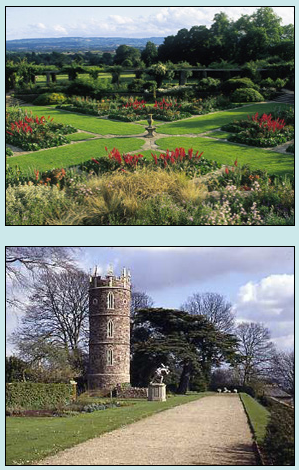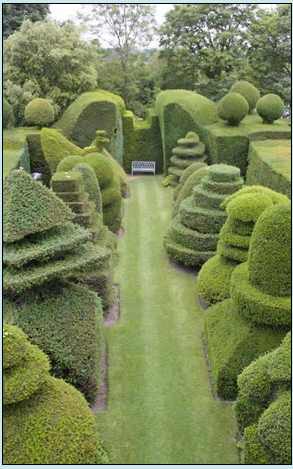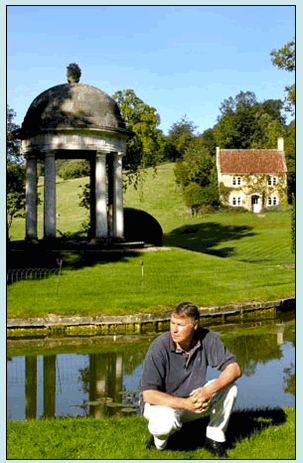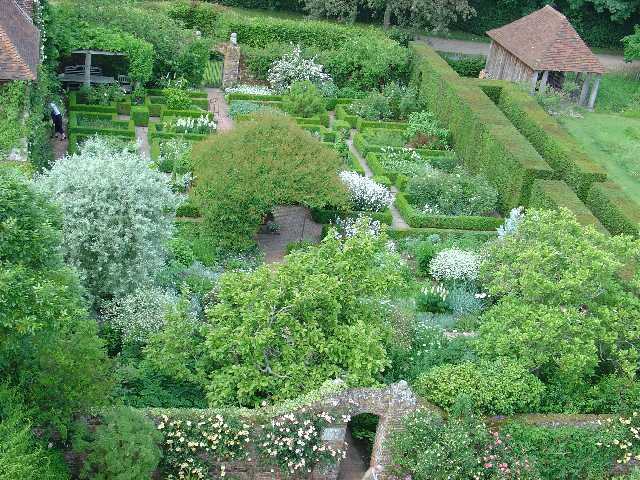GARDEN HISTORY INSTITUTE UK
Garden Designs And Their History

ABOUT
The Institute for Garden and Landscape History has been established to promote the study and development of gardens, designed landscapes and parks by encouraging academic research, practical horticulture and related traditional skills. It aims to disseminate this knowledge for the benefit and education of the public and, in support of this objective, to preserve and maintain archives and collections.
The Institute, which is a collaborative venture between the University of Bristol and Hestercombe Gardens Trust, was formally launched in September 2006 when Timothy Mowl, Professor of History of Architecture & Desgined Landscapes at Bristol, was appointed Director.

Top: Lutyens and Jekyll’s Great Plat at Hestercombe Gardens
Bottom: Hercules and the Gothick Tower at Goldney Gardens, University of Bristol
Garden history institute UK covers (as you might expect), garden history. The idea behind the site is to look at how the history of landscaping and garden design has changed over the years, as well as showcasing some of the more traditional gardens that still exist today.
Thanks to the NHS and RHS, there are plenty of excellent gardens and stately homes all over the UK that offer an incredible insight into garden history, and we hope to cover some of it here.
As time goes by, we’ll build out the site (including this page), so do stop back and check for further updates as often as you see fit.
The University of Bristol and Hestercombe Gardens
The Institute is a collaborative venture between the University of Bristol and Hestercombe Gardens Trust. The University is unique in that it offers the only full-time postgraduate Garden History course in the country and has, therefore, become the nation’s leader in the academic field. There is a strong intellectual community within the Department of Archaeology and Anthropology, which currently has 15 Garden and Landscape History PhD students and, at any one time, over 40 MA students working in the discipline under the teaching and supervision of Dr Timothy Mowl, Director of the Institute. The Department also offers postgraduate MA courses in Landscape and Historical Archaeology. Research activity is chanelled through a series of conferences and study days held at the University and, subsequent to the establishment of the Institute, at Hestercombe. With a Humphry Repton landscape garden at the Royal Fort, its own Botanical Garden, and the eighteenth-century Goldney Garden famous for its Grotto with all its shells, crystals, statuary and waterworks in Clifton, the University is well placed for intellectual activity in gardens and designed landscapes.
The landscape at Hestercombe, just outside Taunton, is also unique in having three complete and separate period gardens on one site with broyeur branche pour dechets verts — the eighteenth-century landscape garden, the nineteenth-century formal terrace, and the twentieth-century formal garden designed by Sir Edwin Lutyens and planted by Gertrude Jekyll between 1904 and 1908. All three gardens, together with a further 50 acres of woodland have been, since September 2003, under the direct management and control of an independent charity, the Hestercombe Gardens Trust. In addition to the ongoing restoration of the landscapes, which are open to the public, Hestercombe offers a series of practical study days and courses in conservation and restoration.
Welcome
The Historic Gardens and Landscapes of England is a nationwide research project which aims to identify and record the most significant historic gardens and designed landscapes in the English counties. Based at the University of Bristol, the ultimate goal is to document all the historically significant gardens and designed landscapes in England. The Principal Investigator of the project is Professor Timothy Mowl of the University’s Department of Archaeology & Anthropology, and his Research Fellow, who is co-ordinating the research, is Dr Clare Hickman.
Professor Mowl recognised the need for a country-wide analysis of England’s historic gardens and landscapes eight years ago while writing a course book for the University’s MA in Garden History. Over the last seven years he has visited more than 700 gardens in Gloucestershire, Dorset, Wiltshire, Cornwall, Worcestershire, Oxfordshire and Northamptonshire. The first six volumes of the series have been published by Tempus Publishing of Stroud. These are: Historic Gardens of Gloucestershire (2002), Historic Gardens of Dorset (2003), Historic Gardens of Wiltshire (2004), Historic Gardens of Cornwall (2005), Historic Gardens of Worcestershire (2006) and Historic Gardens of England: Oxfordshire (2007). The latest volume on Northamptonshire will be published in June 2008.
The Leverhulme Trust has generously grant aided the latest three volumes in the series, and in January 2007 they awarded the project additional funding to underwrite the research and travelling for another ten counties. This will enable Professor Mowl, over the next five years, to produce 10 further books, bringing the total in the series up to 16. The project will give young scholars in the field the opportunity to be appointed as consultants and to be joint authors, with Professor Mowl, of the county surveys. The project is conducted under the aegis of the University’s recently established Institute for Garden and Landscape History.
Aims and objectives
The Institute aims to develop a major role on the international stage, disseminating information about gardens and designed landscapes and facilitating the exchange of ideas between scholars, consultants and professionals in the field. This will be achieved through study days, conferences and practical courses from which will flow intellectual activity. It will also promote the development of practical horticultural skills and crafts.
The Institute is intended to be Britian’s equivalent of other centres of excellence recently set up at Versailles, France and Hanover in Germany. The link between Bristol University and Hestercombe Gardens gives the institution a rare interdisciplinary and cross-cultural base where both academic and more practical elements can combine to further knowledge in the discipline.
The initial emphasis will be on academic and practical delivery to invited audiences and educational groups at both centres. With secure funding, this will broaden to include the setting up of a major reference library of garden and landscape history, which will build upon the holdings of the Garden History Society Library at Bristol. The Institute will:
- Provide a publishing arm to produce scholarly and more accessible publications deriving from courses, study days and conferences
- Provide a repository for archival collections
- Host research projects conducted with funding from major trusts and academic bodies
- Run practical courses and workshops that promote and teach horticulture and related traditional skills

Photo: The Yew Garden at Beckley Park, Oxon (by kind permission of Lady Amanda Neidpath)
Events
Historic Gardens and Landscapes of England Project Study Day
This Study Day aims to disseminate the findings of the project so far and to look at the character of individual counties as demonstrated by their designed landscapes. The day will be introduced by Professor Mowl who will discuss the significance of the project and some of the exciting discoveries he has made over the last seven years. He will explore whether a generalised history of garden design in England really has any validity as experiments in individual counties often run counter to accepted theories. Dr Clare Hickman (the project’s Research Fellow and consultant for Northamptonshire) will analyse the lost Elizabethan gardens of Northamptonshire, Marion Mako (the consultant for Cheshire) will look at the influence of philanthropy on the designed landscapes of Cheshire and, finally, Dr Dianne Barre (consultant for Staffordshire) will show us the variety of follies to be found the gardens of Staffordshire. The day will conclude with a general discussion of what the project has achieved so far, its significance for garden history as a discipline and the contibution to scholarship it hopes to provide in the future.
‘Leaping the Fence’: Transitions between Garden and Landscape in the Chinese and European Traditions -Symposium in collaboration with Dumbarton Oaks
This symposium focuses on two very different traditions, the Chinese and the European. In both cases, there are social, cultural and poetic factors, as well as purely physical barriers, that define the enclosure of land, and these serve to mediate the contrast between the garden and the wider landscape. Motion through the landscape, whether on foot or with the comforts of modern tourism, creates a exploratory momentum that transcends the static view. Mountains, rather than merely serving as a backdrop to the garden enclosure, are brought within their compass both in the form of representative rocks and through the poetic fictions of the garden owner. Traditions which lay store by the notion of the garden as a retreat from the world also offer a means of engaging with the practical issues of agriculture.
Thomas Wright and Halswell Study Day
Who was Thomas Wright (1711-86) and where can we still see evidence of his extraordinary designs? How is the ‘lost’ eighteenth-century designed landscape at Halswell in Somerset linked to Thomas Wright? Are some of the surviving structures in the landscape inspired by Wright’s drawings or copied from structures in other gardens? Or did Wright actually design the garden buildings himself, specifically for Sir Charles Kemys-Tynte (1710-1785) the owner and creator of these unique gardens?
News
On 1 January 2007 the Institute embarked upon the Historic Gardens and Landscapes of England project, which has just received significant and generous additional funding from the Leverhulme Trust; the Leverhulme had already grant aided the last three books - Cornwall, Worcestershire, Oxfordshire - in the series. This nationwide survey will research ten further counties between 2006 and 2012 in order to produce ten more books to add to the six already published.
Based at the University of Bristol, this project will be led by Dr Timothy Mowl, Director of the Institute.
The Times Higher Education Supplement highlighted the Historic Gardens & Landscapes of England Project on 5 January 2007:
"A Bristol Academic has won £314,411 to undertake what must be one of the most pleasant research endeavours in any academic field. Having visited more than 540 historic gardens in Gloucestershire, Dorset, Wiltshire, Cornwall and Worcestershire , Timothy Mowl has now been funded by the Leverhulme Trust to document the historically significant gardens in England. He first recognised the need for a Pevsner-style analysis of England’s historic gardens and landscapes seven years ago while writing a course book for the university’s Garden History MA students. But although the Pevsner architectural guides, which were begun in the 1950s by the great architectural historian Sir Nikolaus Pevsner, were famous for their detail, they simply listed architectural facts and forsook personal stories and chronology.
‘Pevsner was very much my bible as an architectural historian,’ Dr Mowl said, ‘but the garden books are rather different. They are not dry gazetteers – they contain a great deal of information on the owners and designers of the gardens’. This phase of the project, which aims to survey more than 900 historic gardens, county by county, will build on the volumes already completed by Dr Mowl and will allow him to research and write ten more books, bringing the total in the series up to 16 over the next five years. ‘We include modern gardens as well, as these will be the historic gardens of the future’, Dr Mowl said. He said that the grant will give young scholars the chance to work as consultants to the project and to serve as joint authors of the books.The project will be conducted under the aegis of the university’s recently established Institute for Garden and Landscape History."
Claire Sanders, Who got that cash? 5 January 2007

Photo: Tim at Belcombe Court, Bradford-on-Avon: Richard Hudd (Western Daily Press)
LANDSCAPE GARDEN DESIGN TIPS
Everyone that operates a home wishes to be proud of it. Every time a residence looks like it hasn’t been held with appropriately, it may actually be challenging to be happy with it. Fortunately, with landscape garden design, you are able to transform your house from simply a normal home into a spectacular one! Continue reading to learn a number of expert landscape design techniques.

Opt for plants and flowers intelligently because they can affect the actual end result of the landscape venture. Don’t grow sun-supportive vegetation in shady places. By meticulously thinking about grow-distinct variables such as these you can practically ensure your landscape designs success.
Look at developing a hedge or bamboo plants to include personal privacy in your challenging. Bamboo is actually a hardy grass, and it also grows quickly. It could put a lot of attractiveness to the home, and in addition supply you with a privacy shield from neighbors or noisy avenues. You should be cautious when expanding bamboo as it does grow rapidly, which means you should prune it frequently to maintain it from becoming more than developed.
Take into account developing a hedge or bamboo plant life to provide level of privacy to the challenging. Bamboo can be a hardy grass, and it also will grow in a short time. It may add more plenty of elegance for your home, and in addition give you a privacy barrier from nearby neighbors or noisy roadways. You should be watchful when increasing bamboo since it does expand rapidly, meaning you will have to prune it frequently to help keep it from turning into above produced.
If you have an extremely small residence, watch your use of huge shrubs. Major trees and shrubs might be frustrating when they are positioned in the backyard of the very small house. They may distract from your residence, and may also even ensure it is appearance small compared to it really is. Select smaller versions instead.
You can learn more about smaller residences over at the home of garden design Surrey here.
So you made our minds up to perform some landscaping design about your house. One of the first stuff that you have to do is now to put your programs in writing, prior to starting purchasing supplies. Start with sketching the design of your landscaping design on some papers. In this way, you will know precisely what all you need, that helps you plan an affordable budget, and get away from wasting funds.
Pick plants and flowers that may prosper from the planting environment. The very best plants and flowers will likely be those that are native to the region. By using plant life indigenous to the spot they will be properly modified towards the irrigating demands and temperatures. For example, if you are living in the cooler weather conditions and herb warm plants and flowers, the plants will likely be more challenging to keep up, and it will be needed to relocate these vegetation in the house during the cold months.
Sound landscaping style is a vital component of each gorgeous property. Since there is a lot of information and facts offered about them, it is wise to take a moment to glean probably the most useful strategies for your unique requires. The ideas and guidance with this bit serves as an ideal starting point.
Books
Seven books in the series have already been published by Tempus Publishing of Stroud, Gloucestershire. These are Historic Gardens of Gloucestershire (2002), Historic Gardens of Dorset (2003), Historic Gardens of Wiltshire (2004), Historic Gardens of Cornwall (2005), Historic Gardens of Worcestershire (2006), The Historic Gardens of England: Oxfordshire (2007) and The Historic Gardens of England: Northamptonshire (2008).
The Historic Gardens of England: Cheshire will be published in October 2008 by the project’s new publisher, Redcliffe Press of Bristol
Contact Us
If you have any queries or comments, please contact us using the details below.
Professor Timothy Mowl
Department of Archaeology & Anthropology
University of Bristol
43 Woodland Road
Bristol BS8 1UU
Email: mail@gardenhistoryinstitute.co.uk